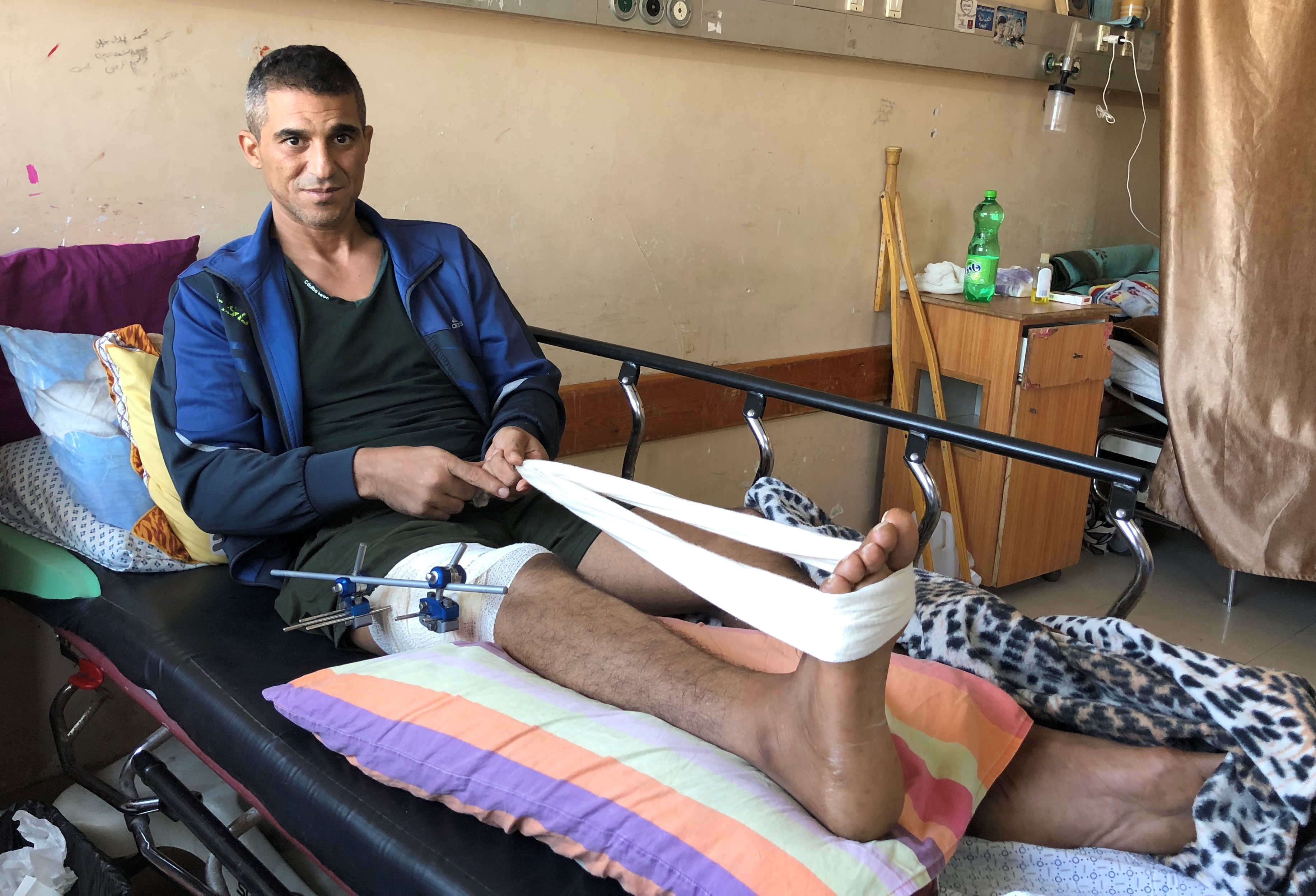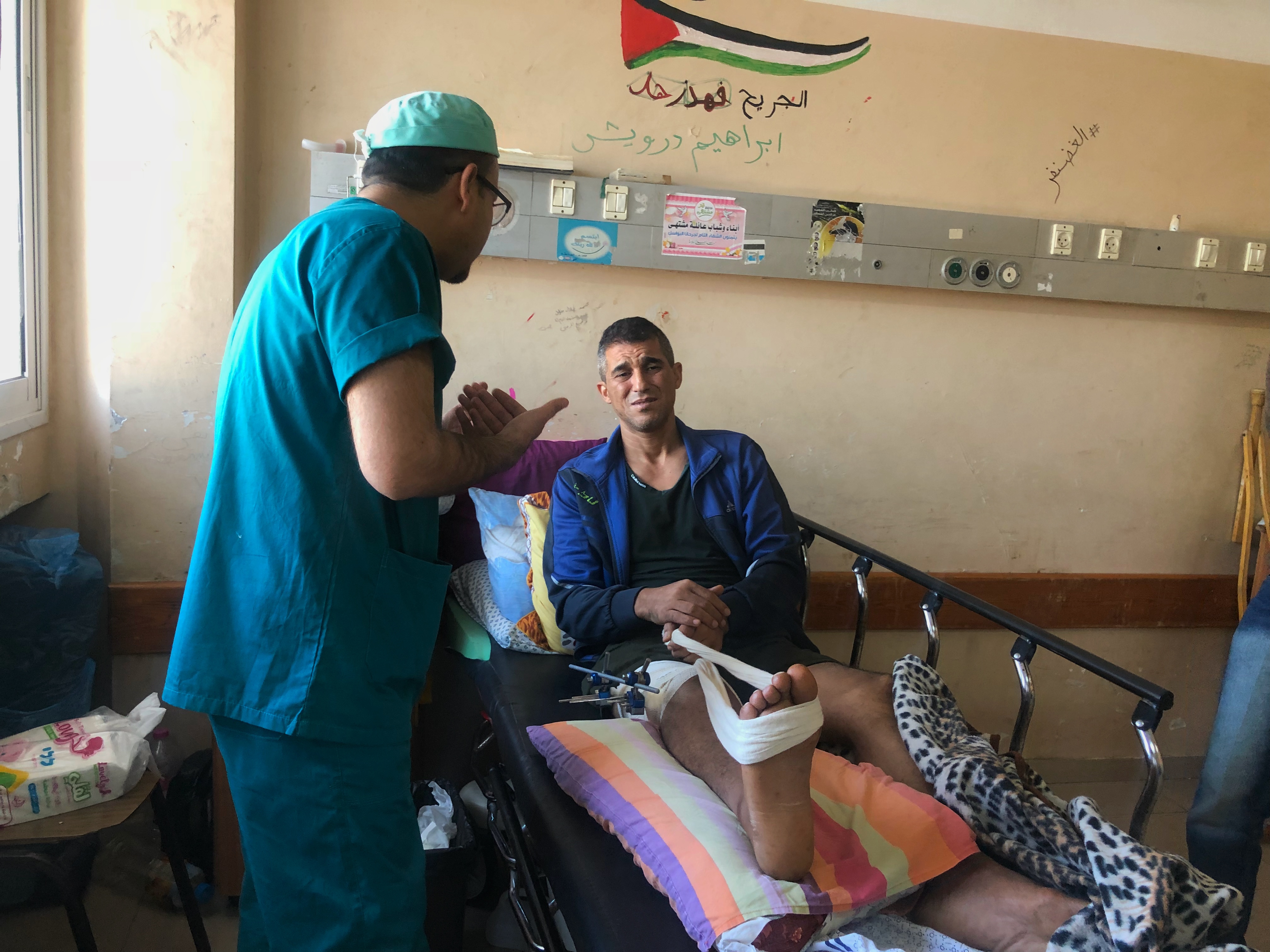 21 November 2018 – Rami, 40, sits in the hospital bed stretching his right leg with a piece of white fabric to avoid stiffness in the joints. He cannot walk. He has a severely comminuted right femur fracture caused by the gunshot injury he received in October, during the mass demonstrations in the Gaza Strip. Rami’s leg is temporarily stabilized with an external fixator. But to stimulate bone growth and avoid long-term disability he needs a circular frame that is currently unavailable in Gaza.
21 November 2018 – Rami, 40, sits in the hospital bed stretching his right leg with a piece of white fabric to avoid stiffness in the joints. He cannot walk. He has a severely comminuted right femur fracture caused by the gunshot injury he received in October, during the mass demonstrations in the Gaza Strip. Rami’s leg is temporarily stabilized with an external fixator. But to stimulate bone growth and avoid long-term disability he needs a circular frame that is currently unavailable in Gaza.
Due to the chronic shortage of medicines and medical equipment, even the largest Gaza hospital, Shifa, cannot provide Rami and many other patients with much-needed health services.
Since 30 March 2018, over 24 000 Palestinians have been injured in Gaza during the Great March of Return demonstrations. The mass influx of casualties has disrupted an already fragile health system. In the hospitals, trauma patients are prematurely discharged to make room for new patients.
 The Ministry of Health and Palestinian Red Crescent Society’s 10 trauma stabilization points (TSPs), supported by WHO, have helped to substantially reduce the burden on the overloaded hospitals. At the TSPs, set up throughout critical zones in Gaza, wounded patients receive life-saving care close to the point of injury. Almost 50% of the injured patients are treated at the TSPs and immediately discharged.
The Ministry of Health and Palestinian Red Crescent Society’s 10 trauma stabilization points (TSPs), supported by WHO, have helped to substantially reduce the burden on the overloaded hospitals. At the TSPs, set up throughout critical zones in Gaza, wounded patients receive life-saving care close to the point of injury. Almost 50% of the injured patients are treated at the TSPs and immediately discharged.
Still, since the end of March, over 12 000 injured patients have been transferred for treatment to hospital. Initial screening found that at least 460 Palestinians will need long-term limb reconstruction, which requires up to seven surgeries and extensive rehabilitation for up to two years. As the screening continues, this number is expected to grow.
Confined to bed, Rami has been waiting for treatment for over a month now. A father of six, he is almost crying: “My leg is not fixed well, and I can feel it’s moving. I need a proper fixator for my leg to heal. If I am disabled, I won’t be able to support my family.”
“If we do not receive a circular external fixator for Rami as soon as possible we will offer him a referral for treatment outside Gaza,” says Dr Mahmoud Matar, an orthopedic surgeon at Shifa hospital. But to receive health care abroad, Palestinians must apply for Israeli security permits. The approval rate for those injured in demonstrations near the fence is significantly lower than the overall approval rate. Only eight out of 52 applications were approved in October.
 Another option for Rami is to go undergo complex surgery in Gaza, but that might result in deformity, limping and persistent pain.
Another option for Rami is to go undergo complex surgery in Gaza, but that might result in deformity, limping and persistent pain.
“Do you know what is the hardest feeling is for me as a doctor?” Dr Matar says. “To be unable to serve the patients. It is an internal disaster. Every time I can’t provide needed care for my patients, I feel like a criminal.”
With generous support from donors, WHO and its partners are procuring life-saving medicine, medical equipment and disposables for the hospitals in Gaza. Still, the needs are growing and the response takes time and resources. To date, there is a gap of US$ 20.8 million to cover emergency health needs in Gaza until the end of the year.
 WHO’s emergency health support for trauma management in the occupied Palestinian territory is funded by generous donations from the European Union, the UN Central Emergency Response Fund and oPt Humanitarian Pool Fund. In 2018, WHO and its health cluster partners require US$ 43.8 million to support health needs in Gaza, of which approximately 53% is currently funded.
WHO’s emergency health support for trauma management in the occupied Palestinian territory is funded by generous donations from the European Union, the UN Central Emergency Response Fund and oPt Humanitarian Pool Fund. In 2018, WHO and its health cluster partners require US$ 43.8 million to support health needs in Gaza, of which approximately 53% is currently funded.


